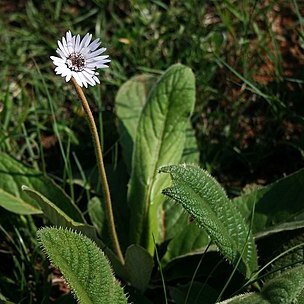Herb with woody rootstock and fleshy roots; crown of rootstock densely woolly with long white hairs.. Leaves ± prostrate, petiolate; petiole 2–20 cm long; blade obovate or elliptic, 4.5–9.5(–20) cm long, 1.5–4(–9) cm wide, base subtruncate, rounded or cuneate-attenuate, margins sinuate-denticulate, remotely denticulate or subentire, apex obtuse or rounded, apiculate or obscurely acuminate, pinnately veined, strongly discolorous, silvery grey with short dense persistent tomentum beneath, dark green, finely scattered pilose, glabrous except for long hairs on the midrib or glabrous above, fringed with short sometimes glandular hairs at the margins.. Scapes 1–2 from each rosette, sometimes precocious, green, 20–60 cm tall, pubescent with fine tomentum and longer ± spreading cottony hairs, ± glabrescent in lower part, sometimes also with glandular hairs, not or little inflated below the capitulum, ebracteate; capitula with the rays ± twice as long as the involucre, ± 2.5 cm in diameter; involucre cylindrical with brownish tomentum and longer cottony hairs at the base, 10–15 mm long, becoming broader and slightly longer in fruit; phyllaries ± 35, lanceolate, acute, thinly pubescent to densely brownish-tomentose, sometimes glandular, green or variously tinged purple or brownish, the longest ± 11 mm long.. Outer florets ± 20, female; corolla 13.5–14 mm long, with the outer lip ray-like, yellow, orange or white and then usually tinged pink to purplish beneath, 10–12 mm long, 2.5–2.7 mm wide; outermost inner florets ± 20, female, innermost ± 60, hermaphrodite; corollas ± 8 mm long.. Achenes fusiform, brown, 6.5–7 mm long, 8–10-ribbed, somewhat arcuate, attenuate into a beak somewhat shorter than the body of the achene, densely shortly pilose; pappus of deep tawny brown or (not in East Africa) purplish shortly barbellate bristles, 6–8 mm long.
Perennial herb, acaulescent; crown whitish silky villose. Leaves in basal rosette; blade narrowly ovate, narrowly obovate, elliptic, oblong or ovate to subrotund, margins entire or sinuate, with remote, obscure teeth, ciliate; upper surface green, glabrescent to densely velvety pilose with light hairs, lower surface persistently whitish or lemon-tomentose; petiole up to 200 mm long. Heads radiate, solitary, on long peduncles (scapes). Scapes up to 0.5 m high, villose or tomentose, not swollen below head. Flowers: ray florets biseriate, prominent, white above, pink, mauve or red below, rarely yellow; disc florets white, yellow, reddish or blackish; Oct.-Feb. Fruit with cypsela hairy, with beak 1-4 mm long. Pappus of many barbellate bristles, violet-purple, rarely whitish or whitish tawny.
Perennial herb, 0.15-0.50 m high; from thickened woody rootstock; root crowns densely silky-lanate. Leaves radical, ascending or spreading, petiolate, elliptic or oblong, apex rounded mucronate, margins sinuate-denticulate, undulate or coarsely crenate-denticu-late, upper surface at first pilose-hispid, lower surface thinly crisped, pubescent to gla-brescent. Capitula solitary, erect; involucres broadly obconic; involucral bracts narrowly lanceolate to narrowly elliptic. Ray florets white above, pink below, or yellow and then coppery below. Disc florets bisexual, inner functionally male. Flowering time Aug.-May. Pappus of many scabrid bristles, whitish. Cypselae elliptic, shortly beaked, pubescent.
Outer florets female, of two kinds; a marginal series of ray-florets with the outer lip erect 8–12 x 1–2.5 mm., oblong-elliptic or narrowly oblanceolate, minutely 3-dentate, yellow in the Flora Zambesiaca area, the inner lip of 2 c. 1.2 mm. long linear often curled lobes, pappus copius several seriate of minutely barbellate setae 4–6 mm. long, achenes to c. 6 mm. long narrowly flask-shaped and ± beaked when mature, 6–10-ribbed, sparsely to densely minutely hispid; a submarginal series of fewer bilabiate florets, corollas 6–7 mm. long, the outer lip 1.5–2 mm. long and minutely 3-dentate, the inner lip of 2 erect linear lobes, the pappus and achenes as for the outer florets.
Leaves radical, ascending or spreading, very variable, usually petiolate; petiole up to c. 26 cm. long, but usually shorter; lamina up to c. 20 x 6.5(9) cm., but usually smaller, broadly oblong-elliptic or oblanceolate, rounded or sub-obtuse mucronate at the apex, cuneate to ± rounded below and shortly somewhat asymmetrically decurrent on the petiole, rarely sub-cordate, margins entire to sinuate-denticulate undulate, upper surface ± patent hispid-pilose to glabrescent, lower surface whitish to lemon-yellow appressed lanate-tomentose.
Acaulescent perennial herb. Leaves entire or sinuate, with remote, obscure teeth, lanceolate, oblanceolate, elliptic, oblong or ovate to subrotund, lower surface persistantly whitish or lemon tomentose. Scapes not swollen below head. Rays biseriate, prominent. Flowers with rays white above, pink, mauve or red below, rarely yellow, disc white, yellow, reddish or blackish.
Central florets numerous bilabiate, functionally male, corollas yellow, 7–8 mm. long, the limb narrowly cylindric and tapering below, 2-lipped, the outer lip minutely 3-dentate, the inner lip with 2 linear curved lobes; achenes to c. 6 mm. long, somewhat flattened not swelling, minutely pubescent, pappus as for outer florets.
Scapes one-several, often appearing before the leaves, erect slender, up to c. 45 cm. long, densely brown tomentose often becoming white-lanate towards the apex, glabrescent to the base, indumentum dense of short crisped hairs intermixed with few to numerous long pilose hairs.
Capitula solitary erect; involucres mostly 8–14 x 12–25 mm., broadly obconic; phyllaries from c. 4 mm. long outside to c. 14 mm. long inside, narrowly lanceolate, crisped-pubescent to tomentose or densely lanate-pilose outside, often glabrescent.
A herb without a stem. It grows 35 cm tall. It grows from a thickened rootstock. The leaves are parallel to the ground in a ring near the base and 5-10 cm long by 2-4 cm wide. The flowers are yellow, pink or red. .
Tufted, acaulescent perennial, scapes to 35 cm. Leaves elliptic, petiolate, glabrescent or silky above, grey-felted below. Flower heads radiate, scapose, white to yellow with pink to copper reverse.
An acaulescent perennial herb, from a thickened woody rootstock; rootcrowns densely silky-lanate; roots numerous, brown and thong-like, c. 2 mm. in diam.

